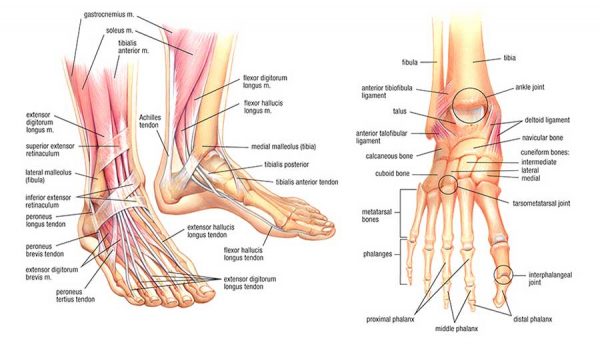“The overall aim of patient education is to improve individual health as well as enhance the performance of the healthcare industry as a whole.” – U.S. National Library of Medicine

Patient Education
Common Conditions Treated at Birmingham FootCare Specialists
Ankle sprains can result from unintentional twisting or forcing of the ankle bones within the foot. This can result in the stretching or tearing of ligaments located on the outer ankle. The level of damage caused is dependent on the severity of the strain and the how quickly the area is properly treated. Ankle sprains may be avoided by wearing properly fitting shoes and regularly exercising.
Typical symptoms of an ankle sprain are: pain, bruising and/or swelling that occurs after a twist or irregular movement of the ankle.
Treatments include:
- Resting and elevating the ankle while applying ice in order to reduce swelling.
- Compression bandages may be used to immobilize and support the injury during healing.
- More serious ankle sprains may require surgery to repair damaged ligaments.
Plantar fasciitis is a painful inflammation of the bottom of the foot that affects the heel and arch. This inflammation targets the connective tissue, called plantar fascia, and stretches from the base of the toes, across the arch of the foot and over to the heel bone. As the foot rolls inward excessively when walking, it flattens the foot, lengthens the arch, and places added strain on the plantar fascia.
This condition, also known as heel spur syndrome, can be treated by:
- anti-inflammatory medications
- icing the affected area
- stretching exercises
- orthotic devices
- physical therapy
Bursitis is an inflammation of the bursa, a small sac of fluid which protects joints, bones and tendons in the foot from friction. Repetitive motion, such as irritation from footwear, can cause the bursa to become inflamed. The heel and the toes are most commonly affected.
Common symptoms of bursitis include redness and swelling of the skin which can become painful.
To treat symptoms, rest the affected area when possible, apply ice to sections affected by swelling, and utilize ibuprofen, padding, or corticosteroid injections to help reduce inflammation and pain.
Surgery may be necessary if these lesser treatments fail to alleviate discomfort.
Corns form on the bottom of your feet and toes because bones are applying pressure to the surface from beneath. As a result, rough sores appear between the toes and under the feet where friction occurs most frequently.
Ill-fitting shoes are the most common source of corns. Hammertoe deformities can also provoke the development of corns. Soaking your feet daily and wearing away at the corn with a pumice stone can greatly reduce the size of the corn. For larger or persistent corns, a doctor may recommend shaving the corn off.
A callus forms as hard, thickened skin that can span across the ball of the foot, the heel, or on the outer side of the big toe. Although many consider them a skin problem, they actually indicate a problem with the bone.
As with corns, calluses form with repeated friction and pressure from footwear rubbing against bones on the toe or foot.
To prevent calluses: switch to better-fitting footwear, wear an orthotic device and/or wear thicker socks.
According to the American Diabetes Association, 25.8 million children and adults in the United States (8.3% of the population) have diabetes.
Diabetic nerve damage can lessen your ability to feel sensations linked to pain, heat and cold. As such, you may not feel a foot injury when it occurs until the skin breaks down and becomes infected. Over time, nerve damage can change the shape of your feet and toes, promote the growth of calluses and foot ulcers, and cause poor circulation.
Here are some basic things for diabetics to consider in keeping your feet healthy.
- Check your feet every day. Look at your bare feet for red spots, cuts, swelling, and blisters. If you cannot see the bottoms of your feet, use a mirror or ask someone else for help.
- Wash your feet every day. Dry them carefully, especially between the toes.
- Keep the blood flowing to your feet. Put your feet up when sitting. Wiggle your toes and move your ankles up and down for 5 minutes, two (2) or three (3) times a day. Don’t cross your legs for long periods of time.
- Don’t smoke.
Fractures or breaks are common in the fifth metatarsal (the long, outer bone connecting to the little toe). Avulsion and Jones fractures are two common breaks that affect this region of the foot.
These different fractures have the same set of symptoms, which include:
- Pain, swelling, and tenderness on the outside of the foot
- Difficulty walking
- Bruising may occur
Heel fractures are generally more severe than the above mentioned breaks, due to the ultra thin nature of the calcaneus (heel bone). When a heel fracture occurs, it’s typically the result of a trauma like falling or spraining your ankle.
Symptoms may vary depending on the severity of the fracture but can include:
- Sudden pain in the heel and inability to bear weight on that foot
- Bruising of the heel and ankle
- Swelling in the heel area
Fungal nails are the result of infected nail beds that can also penetrate the nail above. Fungal nail infections often include a secondary bacterial or yeast infection in or around the nail bed, which can hinder routine physical exercise and make even walking painful.
Symptoms may include: yellowing of the nail, brittleness and/or breakage of the nail.
PinPointe FootLaser is a popular, safe and effective treatment solution for toenail fungus. The clinically proven laser device is designed to target the unsightly symptoms caused by nail fungus using a proprietary pulse modulation system to locate and heat the existing fungus without damaging the surrounding treatment area. Treatment is performed in-office and generally takes only 30 minutes to perform.
In severe cases, surgical treatment may be required to remove the infected nail.
Plantar fasciitis is a painful inflammation of the bottom of the foot that affects the heel and arch. This inflammation targets the connective tissue, called plantar fascia, and stretches from the base of the toes, across the arch of the foot and over to the heel bone. As the foot rolls inward excessively when walking, it flattens the foot, lengthens the arch, and places added strain on the plantar fascia.
Also known as heel spur syndrome, this condition can be treated with the use of anti-inflammatory medications, icing, stretching exercises, orthotic devices, and physical therapy.
Ingrown nails occur when the corners or sides of a nail have grown improperly and begin to dig into the flesh of the toe. This can be very uncomfortable and even painful. Ingrown nails often lead to infection.
Improper nail trimming, pressure from footwear, injury, fungal infection, and heredity are all potential causing factors.
Custom orthotics are medical devices generally prescribed by a foot and ankle surgeon. Operating as shoe inserts, orthotics support and promote proper alignment of the foot and lower extremities. These specialized inserts are formed by making a unique plaster mold of each patient’s individual feet.
This Content is not intended to be a substitute for professional diagnosis or treatment and is provided as a reference only. Always seek the advice of a physician or other qualified health provider with any questions you may have regarding a medical condition.
© Birmingham FootCare Specialists

